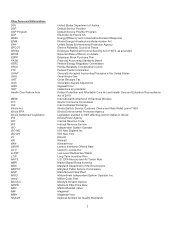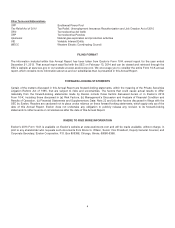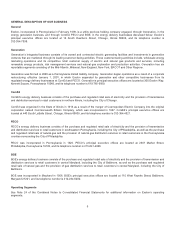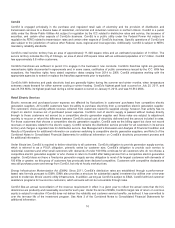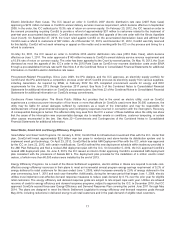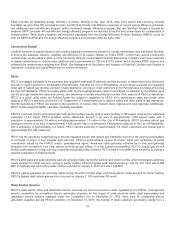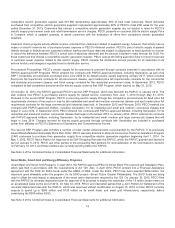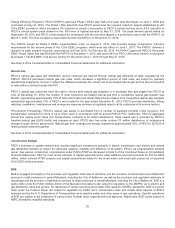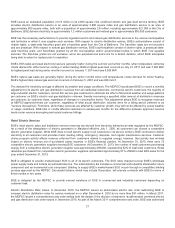ComEd 2013 Annual Report Download - page 17
Download and view the complete annual report
Please find page 17 of the 2013 ComEd annual report below. You can navigate through the pages in the report by either clicking on the pages listed below, or by using the keyword search tool below to find specific information within the annual report.economicallyviable.Additionally, themarket conditionspromptedGeneration to cancel the previouslydeferredextendedpower
uprate projectsat theLaSalle and Limerick nuclear stations. During2013,Generation recordeda pre-taxcharge to operatingand
maintenanceexpenseandinterestexpenseofapproximately$111 million and$8million,respectively, to accrue remainingcosts
andreversethe previouslycapitalizedcosts.
Under thenuclear uprate program, Generation hasplacedinto service projectsrepresenting316 MWs ofnewnuclear generation at
acostof $952million, which hasbeen capitalizedto property, plant andequipment on Exelon’s andGeneration’s consolidated
balancesheets. At December 31,2013,Generation hascapitalized$203 million to construction workin progress within property,
plant andequipment for nuclear uprate projectsexpectedto be placedinserviceby theendof2016, consistingof200 MWs ofnew
nuclear generation,that are intheinstallation phaseacross four nuclear stations; Peach BottominPennsylvaniaandByron,
BraidwoodandDresden inIllinois. Theremainingspendassociatedwiththese projectsisexpectedto be approximately$300 million
through theendof2016. Generation believesthat itis probable that these projectswill becompleted. If a projectis expectednot to
becompletedasplanned, previouslycapitalizedcostswill bereversedthrough earnings asacharge to operatingandmaintenance
expenseandinterest.
Nuclear Waste Disposal. There are no facilitiesfor the reprocessingor permanent disposal of SNF currentlyin operation inthe
UnitedStates, nor hastheNRClicensedanysuch facilities. Generation currentlystoresall SNF generatedbyitsnuclear generating
facilitiesinon-site storage poolsor indrycask storagefacilities. SinceGeneration’s SNF storage poolsgenerallydo not have
sufficient storagecapacityfor thelifeoftherespective plant,Generation hasdevelopeddrycask storagefacilitiesto support
operations.
AsofDecember 31,2013,Generation hadapproximately 59,900 SNF assemblies(14,400 tons) storedon site inSNF poolsor dry
cask storage(this includes SNF assembliesat Zion Station,for which Generation retainsownershipeven though theresponsibility
for decommissioningZion Station hasbeen assumedbyanother party; see Note 15oftheCombinedNotesto Consolidated
Financial Statementsfor additional information regardingZion Station Decommissioning). All currentlyoperatingGeneration-owned
nuclear siteshaveon-site drycask storage,except for Clinton andThree Mile Island. Clinton andThree Mile Islandwill currentlylose
full core reserve, which is when theon-site storage pool will no longer havesufficient spacetoreceiveafull complement offuel from
the reactor core,in 2015and2023,respectively. Drycask storagewill bein operation at Clinton andisexpectedto bein operation at
Three Mile Islandprior to theclosingoftheirrespectiveon-site storage pools. On-site drycask storageinconcert withon-site
storage poolswill becapable ofmeetingall current andfuture SNF storagerequirementsat Generation’s sitesthrough theendofthe
license renewal periods andthrough decommissioning.
For a discussion ofmattersassociatedwithGeneration’s contractswiththeDOE for thedisposal of SNF, see Note 22 ofthe
CombinedNotesto ConsolidatedFinancial Statements.
Asaby-productoftheir operations, nuclear generatingunitsproduceLLRW. LLRWisaccumulatedat each generatingstation and
permanently disposedofat licensed disposal facilities. TheFederal Low-Level RadioactiveWaste Policy Actof1980 providesthat
statesmayenter into agreementsto provideregional disposal facilitiesfor LLRWandrestrictuseofthosefacilitiesto waste
generatedwithintheregion.Illinois andKentucky have enteredinto such an agreement,although neither state currentlyhasan
operational site andnone is anticipatedto be operational untilafter 2020.
Generation is currentlyutilizingon-site storagecapacityat itsnuclear generation stationsfor limitedamountsofLLRWandhasbeen
shippingitsClass ALLRW, which represent 93%ofLLRWgeneratedat itsstations, to disposal facilitiesinUtahandSouthCarolina.
Thedisposal facilityinSouthCarolina at present is onlyreceivingLLRWfromLLRWgeneratorsinSouthCarolina,NewJersey
(which includes Oyster CreekandSalem), andConnecticut.Generation hasreceivedNRCapproval for itsPeach Bottomand
LaSalle stationsthat will allowstorageatthesesitesofLLRWfromitsremainingstationswithlimitedcapacity. Generation nowhas
enough storagecapacityto store all Class B andCLLRWfor thelifeofall stationsinGeneration’s nuclear fleet.During2012,
Generation enteredinto a six year contracttoshipClass B andClass C LLRWto Texas. The terms oftheagreement will providefor
disposal ofall current Class B andClass C LLRWstoredat thestations, aswell asthewaste generatedduringthe termofthe
agreement.Although Texasstartedacceptingwaste for disposal in 2012,theTexassite is curielimited(3.9 million curiesfor 15
years). Withthis limit,the annual facilityvolumewill not match industryproduction ofactivatedhardware,andon-site storageis
expectedto berequiredfor theGeneration boilingwater reactors. Generation continuesto pursue alternativedisposal strategiesfor
LLRW, includingan LLRWreduction programto minimizecostimpactsandon-site storage.
11



